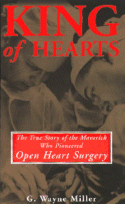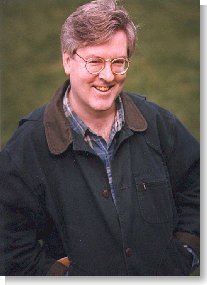The Making of a King
by G. Wayne Miller
 Arguably the biggest challenge facing any writer who hopes to
recreate the past is finding and correctly interpreting primary source
material. Memories of those still living are important, but
unsubstantiated memories are the stuff of memoir. My goal was a
fast-moving, dramatic narrative based on facts, not exclusively a series
of recollections locked inside aging brains.
Arguably the biggest challenge facing any writer who hopes to
recreate the past is finding and correctly interpreting primary source
material. Memories of those still living are important, but
unsubstantiated memories are the stuff of memoir. My goal was a
fast-moving, dramatic narrative based on facts, not exclusively a series
of recollections locked inside aging brains.
Unlike public officials who leave a long paper trail, nearly every character in King of Hearts: The True Story of the Maverick Who Pioneered Open Heart Surgery (Random House/Times Books), was a private individual. Walt Lillehei, the protagonist, opened his extensive files to me -- and that was my first break. Until the last months of his life, Walt was also blessed with a steel-trap memory that checked out time and again (believe me, I checked and rechecked!). And that was another break: a credible subject.
|
King of Hearts * Review * Author Interview |
The three patients who were most important to the book -- Patty Anderson, Dorothy Eustice and Gregory Glidden -- were all dead. Dead for more than 40 years, in fact. One (Dorothy) had never been written about anywhere, not even in the medical literature -- all I had, from Walt, was her name and an approximate date of death. Gregory's operation had been described in the literature and of course Walt remembered it -- but without details of the little boy's life and his family, let alone the day-to-day progress of his case. And when I started, I didn't even have the name of Patty Anderson. All I had was her sex, her age and the date of her operation.
A lot of hard work, a little luck, and a network of contacts in the academic-medicine community that I have built over a long time prevailed.
Let me describe Patty's case as an example.
``A girl of six,'' as Patty was referred to in the medical literature, wasn't much to go on. None of the surgeons who operated on her remembered her name, never mind her social circumstances; she died almost 50 years ago, the surgeons were well into their 80s and even if their memories had been razor-sharp, it wouldn't have mattered. Once you lose a patient, you lose track of the family. And Minnesota law doesn't let just anyone see the records. You need a notarized consent, signed by next of kin.
Here was my first stroke of luck: A sympathetic pathologist showed me the autopsy report. He had blacked out the 6-year-old girl's name, as the law requires, but when I held the report to the light I saw, beneath the black, ``Patty Anderson.''
Anderson of course is one of the -- if not the -- most common surnames in Minnesota. But I knew the date of the operation, from the literature. So I went to the Minneapolis Star-Tribune's morgue and read through the funeral notices for that week. There it was: a 3/4-inch notice, with the names of Patty's parents: Betty and Lloyd. I found no Betty and Lloyd in today's phone book -- that would have been miraculous luck -- so I went to the public library and started following them through old city directories, starting in 1951, when Patty died.
I lost them -- together, at least -- in about 1960. There were still several Betty Andersons and Lloyd Andersons in Minneapolis, but not living together. Had they divorced? Died? Left town, still a married couple? Did they have other children? On through the city directories I went.
Then, in about 1990, luck again: A Betty and Lloyd Anderson reappeared in Minneapolis, living together (turns out they had been in Wisconsin for years). I went to old phone books and found a phone number and an address, for 1990!
But then, seeming bad luck: In about 1993, Betty and Lloyd disappeared. I figured they must have died; they must have been, after all, in their 70s, if not older.
So I was prepared to drive by their last-known address and see if the neighbors remembered them. Before going, I consulted the current city directory -- and found that an Anderson was living right next door. A relative, perhaps?
I called that number, and an elderly woman answered the phone. I asked if she had known a Betty or Lloyd Anderson who had once lived next door. The woman was VERY suspicious; I imagine she thought I was some kind of crook, and she almost hung up on me. But by being exceedingly nice, I managed to coax from her these facts: Betty and Lloyd were indeed dead, and they'd had no other children; but a nephew, now a retired Minenapolis cop, was alive. This woman gave me his phone number.
By the way, this Mrs. Anderson was not related to Betty and Lloyd. She just happened to have the same last name -- and live next door. Did I say Anderson was a common name in Minnesota?
I called the nephew, who turned out to be a great guy. He had photos and memories of Patty and her parents -- and names of many more of Patty's distant relatives, all of whom I interviewed.
He also signed the medical release form, which gave me hundreds of pages of primary-source background in the medical record -- nurses' notes, especially, were useful, as they gave almost an hour-by-hour account of life on the ward. The medical records were the real gold mine. Thank God, they hadn't been thrown away, or lost. Thank God for clerks who know how to file.
The details differ, but getting the stories of Gregory and Dorothy -- indeed, of most of the patients -- involved similar luck, work, and connections.
Hard work more than luck or connections enabled me to tell the story of the book's secondary leading character, the eccentric and driven Dr. Owen Wangensteen, Walt Lillehei's mentor. A legend in surgery and the state of Minnesota even today, Wangensteen had authored hundreds of medical articles, many of which I read. He'd also been the subject of several flattering magazine and newspaper features.
So the scientific side of Wangensteen was well-known. The personal side -- what demons drove him, for example -- had never been published. Again, without a full account, I would have come up half-empty. And Wangensteen was dead.
In our interviews, Walt, ever honest and candid, spoke of Wangensteen's failed first marriage and troubled son, Bud, also long dead. Walt told me that the wife had eventually committed suicide, and Bud eventually turned his back entirely on the famous surgeon after becoming a felon and spending time in an institution. He had a few more details, but of course I needed more. The archives at the University of Minnesota had much useful information. Extensive phone calls delivered me to Wangensteen's two surviving children, who gave me more of the story -- but hardly all. A family geanealogist filled in some pieces. An extensive phone and internet search put me in touch with Wangensteen's grandson -- Bud's son, who sent me a photocopy of a manuscript Bud wrote (he fancied himself a writer, and his writings spoke volumes about his personality). And I tracked down one of Bud's wives, in California; once more, the Internet was invaulable.
But the most productive ore I mined was the courts. Thank God for public records and the First Amendment.
I visited Minnesota five times in the course of writing King of Hearts, and one visit was devoted mainly to court research. I had to visit three separate courts in two cities, but I found: 1. Records of Wangensteen's divorce, deeply detailed; 2. Records of Bud's conviction and subsequent confinement to a mental hospital, also deeply detailed, including a transcript of Bud's appearance before a judge. In a separate quest, the coroner's office in Minneapolis gave me the full report of his ex-wife's suicide.
What use was all this? It explained why Owen loved Walt so, and gave him the extraordinarily long leash to conduct his early ``crazy'' experiments. And it deepened the tragedy when Walt became a federal felon. If they ever do a movie, this is the relationship that will delight a smart director!
The end result was a book that the two leading pre-publication reviewers, Publisher's Weekly and Kirkus Reviews, have praised for its drama -- and thorough research. Thorough, indeed: my source notes and bibliography together run to 41 pages, more than ten percent of the total book!
That, of course, was intentional. With the debate over truth in non-fiction continuing (Edmund Morris's Dutch: A Memoir of Ronald Reagan, for example), I wanted to come down square on the side of facts. Sure, I could have cut corners and made unverified assumptions -- even embellished a bit to move things along or round out a character. But I believe that a true non-fiction writer makes a sacred compact with the reader: to the best of his abilities, he is telling what really happened.
Hopefully, King of Hearts demonstrates that with a lot of time (and a little luck) a writer relying only on the facts can create a powerful true-life drama. It's a formidable challenge, but one worth taking.
 G. Wayne Miller is a senior staff writer at The Providence Journal
and a Random House author of five books, including
King of Hearts: The True Story of the Maverick
Who Pioneered Open Heart Surgery (February 2000), which has
been hailed as The Right Stuff of surgery. He also is
the co-founder of The Cambridge Company, a premium writing,
editing, design and publishing service for quality hardbound
books and integrated Web sites.
G. Wayne Miller is a senior staff writer at The Providence Journal
and a Random House author of five books, including
King of Hearts: The True Story of the Maverick
Who Pioneered Open Heart Surgery (February 2000), which has
been hailed as The Right Stuff of surgery. He also is
the co-founder of The Cambridge Company, a premium writing,
editing, design and publishing service for quality hardbound
books and integrated Web sites.
A graduate of Harvard College, Miller began his writing career
at The North Adams (Mass.) Transcript, which soon led to a job
at The Cape Cod Times. He joined the Pulitzer Prize-winning
Providence Journal in 1981, where he specializes in serial
narratives and has chaired the paper's Writing Committee.
Miller's first book, a novel, Thunder Rise, was published in
1989 by William Morrow. His last four books have all been from
Random House, where his editor from the start has been the
esteemed Jonathan Karp: The Work of Human Hands,
Coming of Age, Toy
Wars, and now King of Hearts. Miller's books
have been widely acclaimed.
Miller is married to Alexis Magner Miller, Home editor of The
Providence Journal, and his partner in The Cambridge Company.
The Millers have three children and live in northwest Rhode
Island.
Miller has just finished a novel about today's media, and is
well into his next Random House book. Visit him at
http://www.gwaynemiller.com.
quotes from the master
improve your writing
spark your creativity
